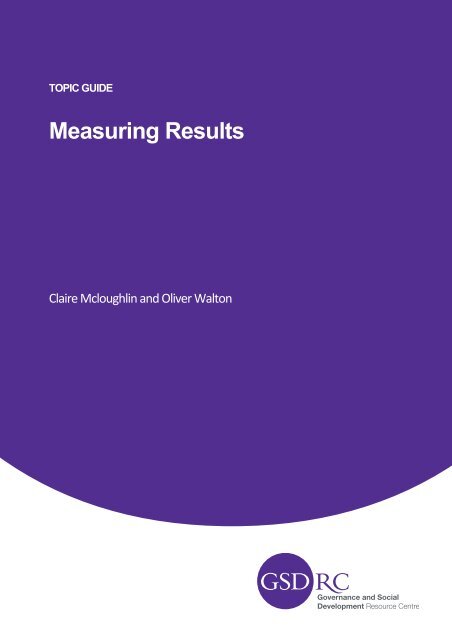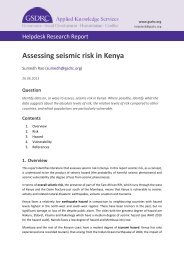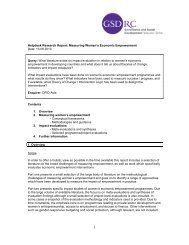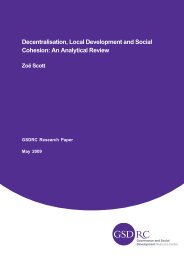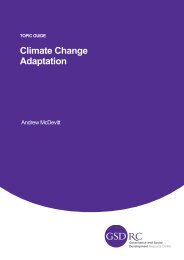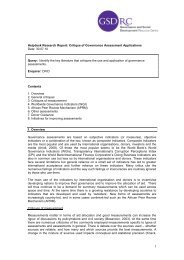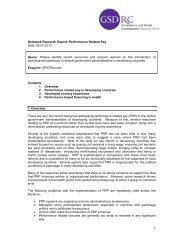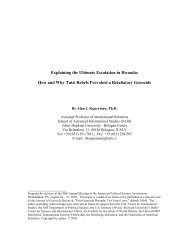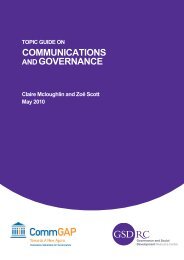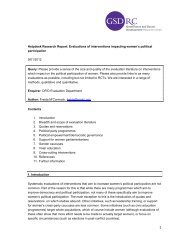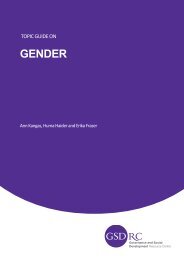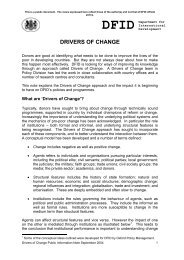PDF (28 pages; 360 KB) - GSDRC
PDF (28 pages; 360 KB) - GSDRC
PDF (28 pages; 360 KB) - GSDRC
Create successful ePaper yourself
Turn your PDF publications into a flip-book with our unique Google optimized e-Paper software.
About this guideHow can the impact of governance and social development programmes be assessed with a view to improving theirefficiency and effectiveness? What particular challenges are involved in monitoring and evaluating developmentinterventions, and how can these be addressed? How can the ‘value for money’ of a particular intervention bedetermined?Monitoring and evaluation (M&E) is vital to ensuring that lessons are learned in terms of what works, what does not, andwhy. M&E serves two main functions: 1) it builds accountability by demonstrating good use of public funds; and 2) itsupports learning by contributing to knowledge about how and why programmes lead to intended (or unintended)outcomes. There can sometimes be a tension between these functions.This guide introduces some of the core debates and considerations for development practitioners involved in designing andmanaging M&E activities. It introduces key tools and approaches, provides case studies of applying differentmethodological approaches, and presents lessons learned from international experience of M&E in a range of developingcountry contexts. While the guide focuses on M&E for governance and social development programmes, it has relevancefor all programmes.The guide was originally prepared by Claire Mcloughlin, and was comprehensively updated by Oliver Walton. The <strong>GSDRC</strong>appreciates the contributions of Claire Vallings and Lina Payne (DFID) and Hugh Waddington and colleagues at 3ie.Comments, questions or documents for consideration should be sent to enquiries@gsdrc.org.About the <strong>GSDRC</strong>The Governance and Social Development Resource Centre (<strong>GSDRC</strong>) provides cutting-edge knowledge services on demandand online. It aims to help reduce poverty by informing policy and practice in relation to governance, conflict and socialdevelopment. The <strong>GSDRC</strong> receives core funding from the UK Department for International Development (DFID) and fromthe Australian Agency for International Development (AusAID).www.gsdrc.orgGovernance and Social Development Resource Centre (<strong>GSDRC</strong>)International Development Department, College of Social SciencesUniversity of Birmingham, UKFirst published July 2011.This updated edition published January 2012.© University of Birmingham
Monitoring and Evaluation (M&E) is an area of growing importance for the development community. It allows thoseinvolved in development activities to learn from experience, to achieve better results and to be more accountable. Thisreport provides an overview of some of the M&E tools, methods and approaches on offer to development practitioners.DFID, 2009, ‘Guidance on Using the Revised Logical Framework’, How to note, Department for InternationalDevelopment, Londonhttp://mande.co.uk/blog/wp-content/uploads/2009/06/logical-framework.pdfTerms and definitionsAid agencies use their own distinct terminology to describe their M&E systems and processes. Nevertheless, the OECDDAC’s definitions of key terms are widely accepted:Organisation for Economic Co-operation and Development – Development Assistance Committee (OECD-DAC), 2002,‘Glossary of Key Terms in Evaluation and Results-based Management’, Working Party on Aid Evaluation, OECD-DAC,Parishttp://www.oecd.org/dataoecd/29/21/2754804.pdfThe DAC Working Party on Aid Evaluation (WP-EV) has developed this glossary of key terms in evaluation and results-basedmanagement to clarify concepts and reduce the terminological confusion frequently encountered in these areas. With thispublication, the WP-EV hopes to facilitate and improve dialogue and understanding among all those who are involved indevelopment activities and their evaluation. It should serve as a valuable reference guide in evaluation training and inpractical development work.Monitoring'Monitoring' is the ongoing, systematic collection of information to assess progress towards the achievement of objectives,outcomes and impacts. It can signal potential weaknesses in programme design, allowing adjustments to be made. It isvital for checking any changes (positive or negative) to the target group that may be resulting from programme activities. Itis usually an internal management activity conducted by the implementing agency.Evaluation'Evaluation' is defined by the OECD-DAC (2002) as:“The systematic and objective assessment of an on-going or completed project, programme or policy, its design,implementation and results. The aim is to determine the relevance and fulfilment of objectives, developmentefficiency, effectiveness, impact and sustainability.”Evaluations can be periodic/formative – conducted to review progress, predict a project’s likely impact and highlight anynecessary adjustments in project design; or terminal/summative – carried out at the end of a project to assess projectperformance and overall impact. They can be conducted internally, externally by independent consultants (particularly inthe case of impact evaluations), or as a joint internal/external partnership.Evaluations are independent, and are published in order to share lessons, build accountability, and investigate the theoryand assumptions behind an intervention. A review, by contrast, tends to be undertaken by people involved in a policy orprogramme. It focuses on whether or not a programme has met its stated objectives, and is usually intended for internaluse.Impact'Impact' is defined by the OECD-DAC (2002) as:“Positive and negative, primary and secondary long-term effects produced by a development intervention, directly orindirectly, intended or unintended.”Impact has another, conceptually different definition, however, which is the difference made by an intervention. An impactevaluation refers to "an evaluation concerned with establishing the counterfactual, i.e. the difference the project made(how indicators behaved with the project compared to how they would have been without it)" (White 2006). Acounterfactual is defined by the OECD-DAC as, “The situation or condition which hypothetically may prevail for individuals,organizations, or groups were there no development intervention” (2002). The conceptual difference is important, sincetechnically speaking an impact evaluation can measure the difference the project or programme made in short or longerterm, or for intermediate or final, or direct or indirect outcomes, for example. However, this definition and the OECDContext and definitions 6
definition of impact are not necessarily at odds, and have for example been brought together in the NoNIE guidelines onimpact evaluation (Leeuw and Vaessen, 2009).Where is a good place to start?For an introduction to both the context and application of M&E in development, see:Kusek, J., and Rist, R., 2004, 'Ten Steps to a Results-based Monitoring and Evaluation System', World Bank, WashingtonDChttp://www.gsdrc.org/go/display&type=Document&id=2668Governments and organisations face increasing internal and external pressures to demonstrate accountability,transparency and results. Results-based monitoring and evaluation (M&E) systems are a powerful public management toolto achieve these objectives. This handbook presents a ten-step model that provides extensive detail on building,maintaining and sustaining a results-based M&E system.7 <strong>GSDRC</strong>, 2012, Topic Guide on Measuring Results
Impact evaluationImpact evaluation: an introductionThe recent emphasis on accountability and results-based management has stimulated interest in evaluating not just theprocess, outputs and outcomes of development programmes, but also their impact (ultimate effect) on people’s lives.Impact evaluations go beyond documenting change to assess the effects of interventions on individual households,institutions, and the environment, relative to what would have happened without them – thereby establishing thecounterfactual and allowing more accurate attribution to interventions.This counterfactual approach to evaluation is increasingly advocated as the only reliable way to develop an evidence baseon what works and what does not in development. There are some 800 quantitative impact evaluations in existence acrossa wide range of sectors, and more are in progress or being commissioned. There is growing consensus that more rigorousquantitative approaches such as randomised control trials should be used more widely, but they are not appropriate in allcontexts.There is growing consensus that where RCTs are not appropriate, there remain a range of quantitative counterfactualapproaches for large n interventions (where there are many units of assignment to the intervention – such as families,communities, schools, health facilities, even districts). It is possible to collect outcomes data using qualitative methods,within the context of a counterfactual evaluation design. For small n interventions (where there are few or only one unit ofassignment – such as an intervention carried out in just one organisation, or one which affects everyone in the relevantpopulation – mixed methods that combine quantitative and qualitative methods may be appropriate. All impactevaluations should collect information along the causal chain to explain not just whether the intervention was effective,but why, and so enhance applicability/generalisabiltiy to other contexts.Lucas, H. and Longhurst, H., 2010, 'Evaluation: Why, for Whom and How?', IDS Bulletin, vol. 41, no. 6, pp. <strong>28</strong>-35http://www.gsdrc.org/go/display&type=Document&id=4040This article discusses theoretical approaches to evaluation and draws on experiences from agriculture and health. It notesthat different stakeholders may have varying expectations of an evaluation and that alternative approaches to evaluationare more suited to meeting some objectives than others. Randomised control trials, or well-designed quasi-experimentalstudies, probably provide the most persuasive evidence of the impact of a specific intervention but if the primary aim issystematic learning a Theories of Change or Realistic Evaluation approach may be of greater value. If resources permit,different approaches could be combined to cover both accountability and learning objectives. As there will be trade-offsbetween objectives, transparency and realistic expectations are essential in evaluation design.White, H., 2009, 'Some Reflections on Current Debates in Impact Evaluation', Working Paper 1, 3ie, New Delhihttp://www.gsdrc.org/go/display&type=Document&id=4103There is a debate in the field of impact evaluation between those promoting quantitative approaches and those calling fora larger range of approaches to be used. This paper highlights four misunderstandings that have arisen in this debate. Theyinvolve: 1) crucially, different definitions of 'impact' – one based on outcomes and long term effects, and one referring toattribution; 2) confusion between counterfactuals and control groups; 3) confusion of 'attribution' with sole attribution;and 4) unfounded criticism of quantitative methods as 'positivist' and 'linear'. There is no hierarchy of methods, butquantitative approaches are often the best available.Asian Development Bank, 2011, 'A Review of Recent Developments in Impact Evaluation', Asian Development Bank,Manilahttp://www.gsdrc.org/go/display&type=Document&id=4220How can impact be credibly attributed to a particular intervention? This report discusses the merits and limitations ofvarious methods and offers practical guidance on impact evaluation. A rigorously conducted impact evaluation producesreliable impact estimates of an intervention through careful construction of the counterfactual using experimental or nonexperimentalapproaches.Attribution and the counterfactual: the case for more and better impactevaluationDevelopment interventions are not conducted in a vacuum. It is extremely difficult to determine the extent to whichchange (positive or negative) can be attributed to the intervention, rather than to external events (such as economic,demographic, or policy changes), or to interventions by other agencies.Impact evaluations attempt to attribute change to a specific programme or policy and establish what would havehappened without the intervention (the counterfactual) by using scientific, sometimes experimental, methodologies suchas randomised control trials or comparison groups.Impact evaluation 8
A number of organisations and networks have emerged in recent years to make the case for more rigorous evaluationmethods. These include the Network of Networks for Impact Evaluation (NONIE), the Abdul Latif Jameel Poverty Action Lab(J-PAL) and the International Initiative for Impact Evaluation (3ie). The final report (2006) of the Evaluation Gap WorkingGroup at the Centre for Global Development is a seminal document calling for greater use of impact evaluation:Center for Global Development, 2006, ‘When Will We Ever Learn? Improving Lives Through Impact Evaluation’,Evaluation Gap Working Group, Centre for Global Development, New Yorkhttp://www.gsdrc.org/go/display&type=Document&id=2685Despite decades of investment in social development programmes, we still know relatively little about their net impact. Sowhy are rigorous social development impact evaluations relatively rare? This paper examines this question and providesrecommendations for more and better evidence for policymaking and programme planning. A new, collective approach isneeded, in which developing country governments, bilateral and multilateral development agencies, foundations andNGOs work together to define an agenda of enduring questions and fund the design and implementation of rigorousimpact evaluations in key sectors.The NONIE guidelines reflect the views of a number of impact and evaluation networks. They stress that there is no single‘best’ method for assessing the impacts of interventions, but that some methods have a comparative advantage overothers in analysing particular objectives. Quantitative methods (experimental or quasi-experimental methods) have acomparative advantage in large n interventions and in addressing the issue of attribution. Certain tools or approaches maycomplement each other, providing a more complete ‘picture’ of impact. The guidelines present a list of eight experimentaland quasi-experimental methods for causal attribution, but acknowledge that other methods may be needed for morecomplex or small n interventions.Leeuw, F. and Vaessen, J., 2009, ‘Impact Evaluations and Development: NoNIE Guidance on Impact Evaluation’, NONIE -The Network of Networks on Impact Evaluation, Washington DChttp://www.gsdrc.org/go/display&type=Document&id=4099This report provides a guide to evaluating the impact of a project or programme. Impact evaluation is about attributingimpacts to interventions, and can play a key role in development effectiveness. No single analytical method is best foraddressing all aspects of impact evaluations, but some methods have an advantage over others in addressing a particularquestion or objective. Different methods can complement each other to provide a more complete picture of impact.Impact evaluations provide the greatest value when there is an articulated need to obtain the information they generate.Randomised Control Trials: the gold standard?Randomised Control Trials (RCTs) are often referred to as the ‘gold standard’ of impact evaluation, but whether or not theyare always feasible, appropriate and rigorous is the subject of some debate. Since RCTs seek to measure a counterfactual,they often require data collection before the start of an intervention, which makes it difficult to apply this approach afteran intervention has begun. One of the key issues with RCTs is the problem of ‘external validity’, or the degree to which thefindings of one study can be generalised to other contexts. Some argue that while RCTs may be suitable for measuringsimple, short-term development interventions, they are less suitable for more complex, long-term interventions, wheremany factors seek to produce change.Duflo, E., and Kremer, M., 2003, ‘Use of Randomization in the Evaluation of Development Effectiveness’, Paper preparedfor the World Bank Operations Evaluation Department Conference on Evaluation and Development Effectiveness 15-16July, 2003, Massachusetts Institute of Technology, Cambridge, UShttp://www.gsdrc.org/go/display&type=Document&id=2626Just as randomised pharmaceutical trials revolutionised medicine in the 20th Century, randomised evaluations couldrevolutionise social policy in the 21st. This paper draws on evaluations of educational programmes. It argues that there isan imbalance in evaluation methodology and recommends greater use of randomised evaluations. As credible impactevaluations, these could offer valuable guidance in the search for successful programmes.Case Study: Progresa in MexicoThe Progresa case is considered one of the most successful examples of the application of a randomised control trial in adevelopment context:Attanasio, O., et al., 2005 ‘Education Choices in Mexico: Using a Structural Model and a Randomized Experiment toEvaluate Progresa’, Institute for Fiscal Studies, Londonhttp://www.gsdrc.org/go/display&type=Document&id=2647What impact have monetary incentives had on education choices in rural Mexico? How can the design of educationalinterventions aimed at improving educational participation be improved? This paper analyses the education component ofthe Mexican government's welfare programme, Progresa, which aims to reduce rural poverty. It argues that increasing thegrant for secondary school children while eliminating it at the primary age would strengthen Progresa's impact.9 <strong>GSDRC</strong>, 2012, Topic Guide on Measuring Results
For further case studies of randomised control trials, see: www.povertyactionlab.com.Adapting to time, budget and data constraintsIdeological positions can obscure the issue of which methodologies are actually feasible. Scientific approaches can becostly, time consuming, and therefore unrealistic. Many organisations do not have the resources to carry out the idealevaluation, and an M&E framework needs to be designed with organisational capacity, human and financial resources andpolitical context in mind. Although it will not be feasible to rigorously evaluate all projects, donors such as DFID nowrequire that all projects must be considered for some form of evaluation as part of the design process. The rationale for thedecision to evaluate or not must be defensible to the UK’s new Independent Commission for Aid Impact.It is important to understand the minimum methodological requirements for evaluation rigour in cases where it is notpossible to use strong evaluation designs.Bamberger, M., 2006, ‘Conducting Quality Impact Evaluations Under Budget, Time and Data Constraints’, World Bank,Washington DChttp://www.gsdrc.org/go/display&type=Document&id=2657How do cost, time and data constraints affect the validity of evaluation approaches and conclusions? What are acceptablecompromises and what are the minimum methodological requirements for a study to be considered a quality impactevaluation? This booklet provides advice for conducting impact evaluations and selecting the most rigorous methodsavailable within the constraints faced. It provides suggestions for reducing costs and increasing rigour and clarifies thenature of trade-offs between evaluation rigour and budgets, time and data.Evaluation designs need to be adapted to local realities: experience demonstrates that no single methodology is applicablein all cases.White, H., 2006, ‘Impact Evaluation: The Experience of the Independent Evaluation Group of the World Bank’, WorldBank, Washington DChttp://www.gsdrc.org/go/display&type=Document&id=26<strong>28</strong>Aid spending is increasingly dependent on proof that interventions are contributing to the attainment of MillenniumDevelopment Goals (MDGs). Yet there is still debate over the definition of impact evaluation and how it should be carriedout. This paper defines impact evaluation as a ‘counterfactual analysis of the impact of an intervention on final welfareoutcomes’ and recommends a theory-based approach. Two sources of bias are highlighted: contamination and selfselectionbias.Mixed-method designsAs discussed in the introduction to this section, quantitative and qualitative methods can be used to answer differentevaluation questions. Quantitative methods are more useful for answering ‘what works’ questions, while qualitativemethods are more useful for answering ‘why’ questions. Quantitative methods are more suited to large n interventions,while mixed methods or just qualitative methods should be used in small n interventions. Mixed methods can help tobolster findings where there are gaps in the data. These approaches are particularly useful for assessing aspects of povertythat are not easy to quantify, such as governance, trust, empowerment and security.Garabino, S., and Holland, J., 2009, ‘Quantitative and Qualitative Methods in Impact Evaluation and Measuring Results’,Issues Paper, Governance and Social Development Resource Centre, Birminghamhttp://www.gsdrc.org/docs/open/EIRS4.pdfThis paper reviews the case for promoting and formalising qualitative and combined methods for impact evaluation andmeasuring results. The case for qualitative and combined methods is strong. Qualitative methods have an equal footing inevaluation of development impacts and can generate sophisticated, robust and timely data and analysis. Combiningqualitative research with quantitative instruments that have greater breadth of coverage and generalisability can result inbetter evaluations that make the most of their respective comparative advantages.A growing issue in development evaluation is the need for M&E practices to reflect and embrace the insights of complexityscience. This involves recognising that the contexts within which governance and development interventions areconducted are unstable and unpredictable, and that existing linear models of causality are ill-equipped to understandchange in these contexts. A complexity perspective implies the need for more flexible and adaptive approaches.Ramalingam, B. and Jones, H. et al., 2008, 'Exploring the Science of Complexity: Ideas and Implications for Developmentand Humanitarian Efforts', Working Paper <strong>28</strong>5, Overseas Development Institute, London, Second Editionhttp://www.gsdrc.org/go/display&type=Document&id=4093What is complexity science? How can it contribute to development and humanitarian efforts? This paper explores the keyconcepts of complexity science and shows how they might help development practitioners engaged in reform. Theconcepts highlight that the best course of action will be context-dependent, and they offer new ways to think aboutImpact evaluation 10
Participatory tools: case studiesThere is no single definition or methodology of PM&E, and it encompasses a wide range of tools and approaches. Commonamong these approaches are values such as shared learning, democratic processes, joint decision making, co-ownership,mutual respect and empowerment. Below are some examples of participatory tools and how they have been used inpractice.Participatory Rural AppraisalParticipatory Rural Appraisal (PRA) encompasses a broad range of methods to enable local people to analyse their ownrealities as the basis for planning, monitoring and evaluating development activities. PRA uses group exercises to facilitateinformation sharing, analysis, and action among stakeholders.Chambers, R., 2007, 'From PRA to PLA and Pluralism: Practice and Theory', IDS Working Paper, no. <strong>28</strong>6, Institute ofDevelopment Studies, Brightonhttp://www.gsdrc.org/go/display&type=Document&id=2786How have the theory and practice of participatory methodologies in development activities changed since the mid 1970s?What variants and applications of these methodologies have emerged? This paper traces the spread of Participatory RuralAppraisal (PRA) and Participatory Learning and Action (PLA), and identifies strengths and weaknesses in the ways they havebeen implemented. Whilst inflexible applications of PRA and PLA may produce disappointing results, when executed withspontaneity and creativity, these approaches can be a source of community empowerment.Beneficiary FeedbackBeneficiary feedback systems seek to collect key stakeholders’ views about the quality and impact of a developmentagency’s work. This approach has grown in popularity and has been supported by a range of donors. While beneficiaryfeedback systems are likely to improve sustainability and can empower beneficiaries, they may present only a partialimpression of beneficiaries’ views, and there has been a lack of rigorous evaluation of their impact. While there is growinginterest in the role that new information and communication technologies can play in scaling up PM&E techniques, theseadvances do not provide a ‘magic bullet’ to improving participation.Jacobs, A., 2010, ‘Creating the Missing Feedback Loop’, IDS Bulletin, Vol. 41, No. 6, pp.56-64http://www.gsdrc.org/go/display&type=Document&id=4090How can development agencies implement feedback systems so as to hear systematically from the intended beneficiariesof their work? How can such systems improve aid accountability, and thus effectiveness? This article focuses onagricultural development, arguing that in most agricultural development projects, quantified summaries of smallholderfarmers' views can be collected. Such data can provide real-time performance indicators that incentivise staff to focus onbeneficiaries' priorities. The feedback process can be empowering in itself, and acting on the feedback can significantlyimprove project impact and sustainability. While measuring performance against plans encourages supply-led and agencycentreddevelopment, using feedback systems can encourage demand-led and people-centred development.<strong>GSDRC</strong>, 2010, ‘Participatory M&E and Beneficiary Feedback’, Helpdesk Research Report, Governance and SocialDevelopment Resource Centre, Birminghamhttp://www.gsdrc.org/go/display&type=Helpdesk&id=619PM&E and beneficiary feedback approaches can improve effectiveness and sustainability and reduce the costs ofmonitoring, but risk generating unrepresentative results and increasing tensions between stakeholders. PM&E should beunderstood as social and political processes: PM&E and beneficiary feedback mechanisms should be tailored to the localcontext and integrated into local political structures and processes.Key Informant InterviewsKey informant interviews are a rapid assessment methodology that can be used as an intermediate indicator of outcomesas an alternative or supplement to full impact assessments.Price, N., and Pokharel, D., 2005, ‘Using Key Informant Monitoring in Safe Motherhood Programming in Nepal’,Development in Practice, vol. 15, no. 2, pp. 151-164http://www.gsdrc.org/go/display&type=Document&id=2627The Nepal Safer Motherhood Project (NSMP) works to improve maternal health and contribute to programmedevelopment at district and national level. This article discusses the project’s use of Key Informant Monitoring (KIM). KIM isan adapted version of the peer ethnographic research method. Data is collected by community-based Key InformantResearchers (KIRs) and used for monitoring and planning. KIRs have proved useful sources of information and acted aschange agents by spreading safer motherhood messages.13 <strong>GSDRC</strong>, 2012, Topic Guide on Measuring Results
Most Significant Change TechniqueThe Most Significant Change (MSC) technique involves the collection of change stories from the field level, and thesystematic selection of the most significant of these. These selected stories are then discussed and critically reflected on tohelp determine the impact of the development programme or activity.Davies, R., 2005, ‘The ‘Most Significant Change’ (MSC) Technique: A Guide to its Use’, MandE, Londonhttp://www.gsdrc.org/go/display&type=Document&id=2672This paper outlines an innovative qualitative monitoring technique known as the 'most significant change' (MSC) approach.The MSC technique is a participatory method of collecting and analysing stories from the field which focuses on monitoringintermediate outcomes and impact. It provides a simple means of making sense of a large amount of complex informationand is best suited to large-scale, open-ended projects that would be difficult to monitor using traditional methods.There is evidence that the most significant change technique can enhance organisational learning and performance.Wrigley, R., 2006, ‘Learning from Capacity Building Practice: Adapting the ‘Most Significant Change’ (MSC) Approach toEvaluate Capacity Building’, INTRAC Praxis Paper no. 12, International NGO Training and Research Centre, Oxfordhttp://www.gsdrc.org/go/display&type=Document&id=2669There is growing recognition of the need to take a multi-stakeholder approach to evaluation, which promotes localownership and builds capacity for reflection, learning, improved performance and self-determination. This paper reflectson the use of the 'Most Significant Change' (MSC) methodology to evaluate the capacity building services of CABUNGO, alocal capacity building support provider in Malawi.Outcome MappingOutcome Mapping is an alternative to theory-based approaches to evaluation that rely on a cause–effect framework. Itrecognises that multiple, non-linear events lead to change. It focuses on people and changes of behaviour and how fardevelopment interventions have built the capacity of the local community. Outcome mapping assumes only that acontribution has been made, and never attempts attribution.Earl, S., Carden, F., and Smutylo., T., 2001, ‘Outcome Mapping: Building Learning and Reflection into DevelopmentPrograms’, International Development Research Centre, Ottawahttp://www.gsdrc.org/go/display&type=Document&id=2687This paper argues that impacts are often the product of events for which no single agency can claim full credit. Outcomemapping moves away from impact assessments to focus on changes in the behaviour of the people it works with directly.The following paper reviews the use of outcome mapping, examining its key advantages, the contexts in which it is mostuseful and how donors can facilitate its use. It finds that outcome mapping works best in situations where theimplementing agency is working in partnership with a range of other stakeholders, is seeking to build capacity, or whentackling complex problems.Jones, H. and Hearn, S., 2009, 'Outcome Mapping: A Realistic Alternative for Planning, Monitoring and Evaluation',Overseas Development Institute, Londonhttp://www.gsdrc.org/go/display&type=Document&id=4098What is Outcome Mapping (OM) and why is it valuable? When does it work best? How can donors facilitate its use? Thisnote draws on case studies to review OM – a flexible, actor- and learning-centred approach to planning, monitoring, andevaluating social change initiatives. It finds that adopting OM for appropriate projects could help development agencies toincrease their effectiveness and meet commitments to managing for results. OM is well-suited to areas involving complexchange processes, capacity building work, and knowledge and decision-making processes. Shifting to OM's learningorientedmode requires donors to adopt more realistic expectations and to dispense with the idea of 'controlling' changeprocesses. Crucially, OM must be underpinned by real trust between the donor, project implementers and partners.The Outcome Mapping Learning Community is an informal community that allows practitioners to share knowledge andexperiences. A number of case studies are available on its website: www.outcomemapping.caGender analysisDevelopment interventions can have differential impacts on men and women: men and women have different needs andconstraints, different opportunities to participate in programme design and implementation, and benefit differently fromoutcomes and impacts. A gender analysis framework should therefore be a component of all evaluation designs. It is alsoimportant to have a gender-balanced evaluation team.World Bank, 2002, ‘Integrating Gender into the PRS Monitoring and Evaluation’ in Chapter 10: Gender of A Sourcebookfor Poverty Reduction Strategies, World Bank, Washington DC, pp.<strong>360</strong>-366http://www.gsdrc.org/go/display&type=Document&id=2705Key monitoring and evaluation tools 14
There is growing evidence that gender-sensitive development strategies contribute significantly to economic growth andequity objectives by ensuring that all groups of the poor share in programme benefits. Yet differences between men's andwomen's needs are often not fully recognised in poverty analysis and participatory planning, and are frequently ignored inthe selection and design of Poverty Reduction Strategies (PRSs). A full understanding of the gender dimensions of povertycan significantly change the definition of priority policy and programme interventions supported by the PRS. This chapterprovides practical guidance on identifying and implementing country-level policies and programmes that will benefit bothmen and women, and maximise potential benefits for poor families.Evaluators have had limited success in introducing gender sensitive approaches to M&E. This is particularly evident in theuse of household surveys which either only interview the household head (usually male) or which interview women incontexts where they are not able to speak freely.Evaluations should address critical gender issues such as time poverty, participation in household decision-making andwomen’s multiple roles (e.g. production, social reproduction and community management).Bambrilla, P., 2001, ‘Gender and Monitoring: A Review of Practical Experiences’, report prepared for the Swiss Agencyfor Development Cooperation, BRIDGE Report 63, BRIDGE, Institute of Development Studies, Brightonhttp://www.gsdrc.org/go/display&type=Document&id=2649How can monitoring and evaluation (M&E) processes be made gender-sensitive? What measures have organisations takento assess their effectiveness in mainstreaming gender? This report provides a tool for integrating a gender approach intoM&E mechanisms.Value for Money‘Value for money’ (VFM) is a term used to describe an ‘explicit commitment to ensuring the best results possible areobtained from the money spent’ (Barnett et al 2010). The term has been used by a number of donors and multilateralagencies as part of their appraisal and evaluation procedures. These include DFID, USAID, DANIDA and the MillenniumChallenge Commission. There is also growing interest in applying VFM frameworks to development programmes.Whilst always present in aid effectiveness discussions, the VFM agenda has increased in prominence as a result of growingconcern with transparency and accountability in government spending. DFID has stated that improving VFM is not simplyan exercise in cost-cutting. It involves addressing economic, efficiency and effectiveness considerations to ensure thatfewer resources are spent where possible, and that these resources are spent productively and are focused on achievingobjectives.The following study highlights several options for improving and assessing value for money. While some approaches aremore focused on management (they are easier to implement and involve a strengthening of existing processes), othersfocus on measurement. The latter represent a more radical departure from existing practice and require more rigorousdata collection. The ‘ratings and weightings’ approach, where programmes are rated according to pre-determinedstandards of economy, efficiency and effectiveness, is arguably the most promising.Barnett, C., et al., 2010, ‘Measuring the Impact and Value for Money of Governance Programmes’, ITADhttp://www.gsdrc.org/go/display&type=Document&id=4115How can value for money best be measured in governance and conflict programming? This study reviews options for aVFM approach in relation to governance programmes, including those in conflict-affected and failed states, for the UK'sDepartment for International Development. VFM involves examining economy, efficiency and effectiveness, identifying thelinks between them and drawing conclusions based on evidence about how well they perform together. It is an optimalbalance that is important, as opposed to a maximum productivity ratio. The cheapest option does not always represent thebest value for money.Donors are using the term ‘value for money’ in different ways. DFID’s approach involves assessing whether results achievedrepresent good value against the costs incurred. Other agencies, such as USAID and the World Bank, aim to achieve VFMthrough rigorous economic analysis or results-based management.<strong>GSDRC</strong>, 2010, ‘Value For Money’, Helpdesk Research Report, Governance and Social Development Resource Centre,Birminghamhttp://www.gsdrc.org/go/display&type=Helpdesk&id=624How are donors approaching ‘value for money’ in their aid programming? DFID appears to have gone the furthest amongaid agencies in developing the concept of ‘value for money’ (VFM). Processes include the use of logframes, economicappraisals and portfolio reviews. Newer initiatives include the adoption of a business case model for project approval andthe development of unit cost metrics in key sectors. Other donors, while not explicitly adopting ‘value for money’terminology, aim to achieve VFM through rigorous economic analysis and results-based management.15 <strong>GSDRC</strong>, 2012, Topic Guide on Measuring Results
Managing monitoring and evaluationBadly designed and managed evaluations can do more harm than good: misleading results can undermine the effectivechannelling of resources for poverty reduction. Designing effective M&E systems is not enough: donors need to commit tosupporting M&E at all stages of implementation, which include selecting appropriate indicators, establishing baselines,collecting quality data, and reporting and using findings effectively. Sustaining an M&E system within an organisation alsopresents considerable ongoing challenges.Establishing international standards for methodological rigour, ethical practice and efficient management processes inM&E is another critical challenge. Key issues include how aid agencies should oversee evaluations outsourced toconsultants, how to build country ownership of M&E processes where there are significant capacity constraints or limitedbuy-in, and how to co-ordinate evaluations of joint donor programmes effectively.Steps in planning and designMonitoring and evaluation activities are usually broken down into the stages of planning, implementation, analysis,dissemination and use.Kusek, J., and Rist, R., 2004, ‘Ten Steps to a Results-based Monitoring and Evaluation System’, World Bank, WashingtonDChttp://www.gsdrc.org/go/display&type=Document&id=2668Governments and organisations face increasing internal and external pressures to demonstrate accountability,transparency and results. Results-based M&E systems are a powerful public management tool to achieve these objectives.This handbook presents a ten-step model that provides extensive detail on building, maintaining and sustaining a resultsbasedM&E system.Aid agencies largely work to their own internal requirements for reviewing, reporting on and evaluating the inputs, processand results of their activities, producing internal guidance notes that describe the practical steps involved.United Nations Development Programme Evaluation Office, 2009, 'Handbook on Planning, Monitoring and Evaluatingfor Development Results', UNDP, New Yorkhttp://www.undp.org/evaluation/handbook/Ensuring evaluation qualityEnsuring the quality and integrity of evaluation design is vital for reaching accurate and reliable conclusions about whatworks and what does not. A key mechanism for ensuring evaluation quality is to establish internal quality control panels.DFID has had such a panel since 2009, providing expert advice, guidance and quality assurance.International standards emphasise the need for impartiality, accountability, appropriately skilled experts conducting theevaluation, participation, country ownership and timeliness (evaluations should be appropriately timed to influencepolicymaking). The OECD DAC Network on Development Evaluation’s principles for evaluation of development assistanceare widely cited.OECD-DAC, 1991, ‘Principles for Evaluation of Development Assistance’, OECD, Parishttp://www.gsdrc.org/go/display&type=Document&id=2688This paper presents a set of principles on the most important requirements of the evaluation process. Developmentassistance is a cooperative partnership between donors and recipients. Both must take an interest in evaluation to improvethe use of resources through learning and to ensure accountability to political authorities and the public.Most donors now also make substantial use of the harmonised DAC Quality Standards for Development Evaluation. Whilethe OECD Principles focus on the management and institutional set up of evaluation systems, the Standards informevaluation processes and products:OECD-DAC, 2010, ‘Quality Standards for Development Evaluation’, DAC Guidelines and Reference Series, OECD, Parishttp://www.gsdrc.org/go/display&type=Document&id=4114The OECD-DAC Quality Standards for Development Evaluation, built through international consensus, provide a guide togood practice. They are not intended to be used as a development evaluation manual, but they outline the key qualitydimensions for each phase of a typical evaluation process: defining purpose, planning, designing, implementing, reporting,and learning from and using evaluation results. Principles informing the whole of the evaluation process are transparencyand independence; integrity and respect for diversity; partnership, coordination and alignment; capacity development; andquality control.Managing monitoring and evaluation 16
There is also a need to ensure that evaluations are conducted ethically, in a culturally sensitive manner that protects theanonymity and confidentiality of individual informants.United Nations Evaluation Group, 2005, ‘Standards for Evaluation in the UN System’, UNEG, New Yorkhttp://www.gsdrc.org/go/display&type=Document&id=2684This document offers solid guidelines for evaluation planning, design, implementation and reporting. Fundamentalrequirements include: institution-wide support, clearly-defined and transparent responsibilities, appropriately qualifiedstaff, and a constant commitment to the harmonisation and updating of methods used.Identifying threats to the validity of evaluation findingsSignificant criticism has been levelled against the development community for failing to adopt methodologically soundapproaches to evaluating their activities. These include weak analysis of qualitative data and not paying enough attentionto mapping the causal chain from inputs to impacts.White, H., 2005, ‘Challenges in Evaluating Development Effectiveness’, IDS Working Paper 242, Institute of DevelopmentStudies, Brightonhttp://www.gsdrc.org/go/display&type=Document&id=2662Evaluation has a crucial role to play in today's results-based culture and in the context of the Millennium DevelopmentGoals. How, then, can the quality of evaluation be improved? This paper argues that there has been inadequate investmentin methodology, often resulting in low quality evaluation outputs. It discusses techniques in three areas: measuring agencyperformance; evaluation methods at the project level; and sustainability analysis.The validity and usefulness of an evaluation are determined, among other things, by its statistical validity, use/actionorientation, transferability and fittingness.Bamberger, M., Rugh, J., and Mabry, L., 2006, ‘Strengthening the Evaluation Design and the Validity of the Conclusions’Chapter 7 in Realworld Evaluation: Working Under Budget, Time, Data and Political Constraints, Sage Publications,Californiahttp://www.gsdrc.org/go/display&type=Document&id=2761How can threats to the validity of evaluations be identified and addressed? This chapter outlines some of the mostcommon threats to the validity of both quantitative and qualitative evaluation designs. It offers recommendations on howand when corrective measures can be taken to ensure validity.See also: Bamberger, M., 2007, ‘A Framework for Assessing the Quality, Conclusion Validity and Utility of Evaluations',Paper presented at the American Evaluation Association Conference of 2007.http://www.realworldevaluation.org/uploads/A_framework_for_assessing_the_quality_and_utility_of_evaluations_GAO_AEA_2007.docEvaluating multi-donor programmesThe Paris Declaration commits donors to co-operation and harmonisation in all stages of the development cycle. Jointevaluations are necessary where multiple agencies are involved in a chain of interventions to pursue similar outcomes, orto understand the combined effects of all interventions across a particular sector.Joint evaluations present opportunities for donors to pool their technical and financial resources for more rigorous, indepthand longer-term evaluations, and to reduce the multiple information demands on governments and stakeholders.However, they require agencies to reconcile their often divergent mandates and preferred evaluation approaches.OECD-DAC, 2006, ‘Guidance for Managing Joint Evaluations’, DAC Evaluation Series, OECD, Parishttp://www.gsdrc.org/go/display&type=Document&id=2663Joint evaluations have become central to development practice in recent years. Collective assessment of agencies’combined work minimises transaction costs for developing country partners and addresses the large aid-giving role ofjoined-up modalities such as basket funds and joint assistance strategies. This booklet provides practical guidance formaking joint evaluations efficient, educational and collaborative.The politics of evaluationEvaluations are more than a technical process. They have the capacity to determine access to resources and the fundingfate of programmes. It is inevitable therefore that they will be subject to pressures from different stakeholders to producefavourable assessments or to avoid addressing sensitive issues.Bamberger, M., Rugh, J., and Mabry, L., 2006, ‘Reconciling Different Priorities and Perspectives: Addressing PoliticalInfluences’, Chapter 6 in Realworld Evaluation: Working Under Budget, Time, Data and Political Constraints, Sage17 <strong>GSDRC</strong>, 2012, Topic Guide on Measuring Results
The Evaluation Capacity Development (ECD) unit of World Bank's Operations Evaluation Department is designed to helpcountries strengthen their M&E capacity. The unit targets 'high-intensity' support to Uganda and Egypt and various othertypes of support to an additional 32 countries. This paper from the World Bank collates some of the main lessons learnedfrom ECD activities and outlines major issues to be addressed.Strengthening national statistical capacityGood statistics are vital for the effective monitoring of development programmes and strategies, and ultimately to supportevidence-based policymaking. However, many developing countries lack the institutional capacity or effective systems forgathering data. Many existing statistical systems were predominately designed to meet immediate rather than long-termdata needs, and therefore lack coordination.There is increasing recognition of the need for a strategic approach to statistical capacity development, particularlyfollowing the Second International Roundtable on Managing for Development Results in February 2004 and the resultingMarrakech Action Plan for Statistics (MAPS). This emphasised the need to develop National Strategies for the Developmentof Statistics (NSDSs).Paris21 Secretariat, 2004, ‘A Guide to Designing a National Strategy for the Development of Statistics (NSDS)’, Preparedby the Partnership in Statistics for Development in the Twenty-first Century (PARIS 21), Parishttp://www.gsdrc.org/go/display&type=Document&id=2650There is increasing awareness of the need to strengthen statistical capacity to support the design, monitoring andevaluation of national development plans. National Strategies for the Development of Statistics (NSDS) are designed toachieve this goal. This guide aims primarily to assist developing countries to design their NSDSs, but will also be useful todevelopment partners.19 <strong>GSDRC</strong>, 2012, Topic Guide on Measuring Results
Applying monitoring and evaluation toolsMonitoring and evaluation tools and approaches are applied in a range of programmes and contexts. This section providesa guide to key resources on using monitoring and evaluation tools in relation to specific governance and socialdevelopment programmes.Evaluating governance programmesTo date, most impact evaluations have focused on economic and social development programmes in the fields of health,nutrition, water, agriculture and education. Relatively few impact evaluations have been conducted on governanceprogrammes. This is due to several factors. Governance programmes are complex and combine a number of objectives,many of which may be difficult to measure. There is also a shortage of reliable baseline data for many governanceinterventions. Despite these problems, experimental methods such as Randomised Control Trials have been used toevaluate corruption, community development and election programmes. Where it is not possible to use experimentalmethods, evaluators should consider using quasi-experimental or mixed methods approaches.Garcia, M., 2011, 'Micro-Methods in Evaluating Governance Interventions', Evaluation Working Papers,Bundesministerium für wirtschaftliche Zusammenarbeit und Entwicklung, Bonnhttp://www.gsdrc.org/go/display&type=Document&id=4101Although billions of dollars have been invested on improving governance in developing countries in the past decade, few ofthe programmes that have received funding have been subjected to rigorous impact evaluation. The aims of the paper areto: (i) discuss the challenges in evaluating governance programmes, (ii) identify some aspects of governance that havebeen rigorously evaluated, and finally (iii) provide practical recommendations based from previous evaluation experience.In recent years, a growing number of studies have used experimental methods to assess the impact of a range ofgovernance programmes and processes. The most common sub-sectors for RCTs are elections, community-drivendevelopment and service delivery. Although there are a number of challenges associated with using RCTs to measure theimpact of governance programmes, these experiments also present ‘immense opportunities’.Moehler, D., 2010, ‘Democracy, Governance and Randomised Development Assistance’, Annals of the AmericanAcademy of Political and Social Science, vol. 6<strong>28</strong>, no. 1, pp.30-46http://www.gsdrc.org/go/display&type=Document&id=4097Are field experiments useful in studying the impact of development assistance on democracy and governance (DG)? Thisarticle reviews recent and ongoing DG field experiments. It considers the prospects for and obstacles to the developmentof a useful body of experimental evidence on the political economy of development. There are significant challengesrelated to the difficulty of generalising from small samples and micro-level projects. However, although the fieldexperiments have tended towards village-level interventions, they suggest that impact evaluations can potentially addresshigher-level interventions and theories.E-Gap is a research network for scholars and practitioners engaged in field experiments on topics of governance, politicsand institutions. Its website provides news and information on current research in this area.Governance indicatorsOne of the most contentious debates surrounding the M&E of governance programmes is the use of governanceindicators. Increasing emphasis on the need to measure ‘good governance’ and how it relates to poverty reduction has ledto a proliferation of worldwide data sets, guidelines and frameworks for assessment. There is considerable debate aboutthe validity of different methodological approaches to measurement, and increasing recognition that measuringgovernance is itself a political process.UNDP, 2007, 'Governance Indicators: A User’s Guide’, Second Edition, United Nations Development Programme, Oslohttp://www.gsdrc.org/go/display&type=Document&id=1155Demand for ways to measure different aspects of democracy, human rights and governance is increasing. This has led to arapid growth in the number of indicators to assess government performance, the quality of institutions and people’sperceptions. This guide offers advice on where to find and how to use governance indicators.When used carelessly, governance indicators can ‘misinform and mislead’. It is important to recognise that governanceindicators are used for a range of purposes and can be distinguished according to their source and objectivity, level ofimpact, comparability, degree of aggregation and ‘actionability’. The following paper presents several pitfalls associatedwith the use of governance indicators and proposes guidelines to ensure more careful use. It highlights the need forproviders of indicators to be subject to greater transparency, scrutiny and peer review.Applying monitoring and evaluation tools 20
Williams, G., 2011, ‘What Makes a Good Governance Indicator’, Policy Practice Brief 6, The Policy Practicehttp://www.gsdrc.org/go/display&type=Document&id=4035What are the most common pitfalls associated with the use of governance indicators? How can these be avoided? Thisbrief examines the different types of governance indicator, their use and their misuse. Users need to ask critical questionsabout what exactly indicators are measuring, and to remember the limited ability of broad governance indicators todemonstrate causality. Process indicators are most relevant to understanding causal mechanisms. Providers of indicatorsshould ensure full transparency in the publication of methodology and source data, and should be subject to greaterscrutiny, evaluation and peer review.Much of the debate around governance indicators has focused on country-level governance monitoring and assessments.Relatively few studies have addressed the question of which kinds of governance indicators are most useful for governanceprogramming. Meso-level indicators that link project/programme results to higher-level impacts have been largely absent,and macro-level indicators have sometimes been used by evaluators to judge projects.In response to these issues, a number of agencies have sought to develop ‘improved’ indicators, by ensuring that theseindicators are either more linked to concrete problems or based on a more participatory approach. DFID has recentlycommissioned an assessment of existing programme-level governance and conflict indicators, (Barnett et al., 2011), whichincludes a revised list of suggested indicators.<strong>GSDRC</strong>, 2010, ‘Evaluation of Governance Programme Indicators’, Helpdesk Research Report, Governance and SocialDevelopment Resource Centre, Birminghamhttp://www.gsdrc.org/go/display&type=Helpdesk&id=608While there is a large body of literature providing advice in selecting and designing indicators, there is little evaluatinggovernance programmes indicators per se. In general, the literature criticises the application of quantitative indicators togovernance programmes, or criticises the confusion on which aspects to monitor. Recently, there has been a growth in'improved' indicators. There is a debate surrounding their validity, however. Participatory and mixed method approachesseem to respond best to criticism of governance assessments.Barnett, C., et al., 2011, 'Governance and Conflict Indicators Report', ITADhttp://www.gsdrc.org/go/display&type=Document&id=4113How can a robust and clear set of indicators be established to monitor effectively the progress of a programme? Whichindicators show best that a programme has achieved what it set out to achieve? This study tests the relevance androbustness of a list of indicators for the Department for International Development's (DFID's) conflict and governanceprogrammes. The list consists of fifteen separate sets, or suites, of outcome and output indicators and covers a spectrumof related programme areas, including security and justice, elections, civil service reform and corruption. It suggests that agood results framework that enables programme progress to be effectively monitored and explained is critical, particularlyin times of financial austerity.In another important initiative, the World Bank has recently sought to catalogue those governance indicators that can beused to measure concrete governance issues that can be addressed directly in governance projects and programmes. TheAGI Data Portal consolidates information on actionable governance indicators, provides a one-stop-shop platform tonavigate these indicators and their documents, and offers customised tools for data management, analysis and display.Another useful resource is the UNDP’s Governance Assessment Portal, which provides a database on country-levelgovernance assessments, a library of publications on governance assessment and a toolbox of frameworks and indicators.Further discussion of governance assessments and governance indicators can be found in the Political Economy AnalysisTopic Guide: http://www.gsdrc.org/go/topic-guides/political-economy-analysis/governance-assessmentM&E in fragile and conflict-affected statesM&E faces unique challenges in fragile and conflict-affected contexts. These include:• Lack of security (both for researchers and the people who talk to them)• Distrust of outsiders and reluctance to talk, or fear of reprisals for talking• Shame in acknowledging sexual violence• Rapidly fluctuating populations (due to migration) and a lack of adequate documentation on the population• Lack of adequate statistical data to generate baselinesGovernment unwillingness to recognise the level of violence or the failure of programmes which might in turn affect aidflows.Elkins, C., 2006, ‘Monitoring and Evaluation (M&E) for Development in Peace-Precarious Situations’, RTI International,Londonhttp://www.gsdrc.org/go/display&type=Document&id=266421 <strong>GSDRC</strong>, 2012, Topic Guide on Measuring Results
How can M&E information systems improve programme impact and assist peaceful development in situations prone toviolent conflict? This paper outlines M&E’s status as a unique discipline and describes M&E strategies and tacticsimplemented in real-world, peace-precarious situations. Even under the stresses of violence and conflict, M&E approachescan help build knowledge of how to advance peace and development.<strong>GSDRC</strong>, 2007, ‘M&E in Fragile States’, <strong>GSDRC</strong> Helpdesk Research Report, Governance and Social Development ResourceCentre, University of Birminghamhttp://www.gsdrc.org/go/display&type=Helpdesk&id=399There is a general consensus on the need to move M&E beyond the project level to the sector and strategic level in fragilestates. It is important to assess the overall impact of interventions on stabilising fragile states and promoting sustainablepeace. Joint evaluations and agreed upon objectives, among government departments (in the case of ‘whole-ofgovernment’approaches) and with other governments and relevant actors, are useful in providing this comprehensivepicture.Conflict prevention, conflict resolution and peacebuilding all aim to have long-term impact in terms of sustainable peaceand development. Given the time-frames and the convergence of a multitude of activities in conflict-affected areas, it maybe difficult to attribute quantifiable results to specific conflict prevention, conflict resolution and peacebuildingactivities. This should not, however, be a deterrent, or an excuse for not conducting assessments.There is consensus that many of the standard criteria for monitoring and evaluation (M&E) are applicable to interventionsin conflict-affected areas. In addition, the OECD-DAC provides a series of common monitoring and evaluation principlesthat can be applied to different types of conflict prevention and peacebuilding interventions. These are: inclusiveness; thetesting of underlying theories of change; the use of qualitative and quantitative methods; testing assumptions andlearning; ethical standards for approaching informants and handling the reporting of findings.The following are a selection of M&E frameworks, tools and recommendations developed by international organisations,donor agencies, academics and non-governmental organisations. They cover conflict prevention, conflict resolution,conflict transformation, stabilisation, and peacebuilding interventions.Conflict prevention and peacebuildingOECD-DAC, 2007,'Encouraging Effective Evaluation of Conflict Prevention and Peacebuilding Activities: Toward DACGuidance', A Joint Project of the DAC Network on Conflict, Peace and Development Co-operation and DAC Network onDevelopment Evaluation, Parishttp://www.gsdrc.org/go/display&type=Document&id=2958The past decade has seen growing numbers of governments and organisations devote resources to interventions intendedto avert or end conflict. How can these be evaluated? This report represents a step in the development of practicalevaluation guidance. Scope, conflict analysis, impacts, skills and tools all need to be considered. Next steps should includedonor experimentation with evaluations, an annual review of evaluations and a policy review.Scheers, G., 2008, ‘Assessing Progress on the Road to Peace Planning, Monitoring and Evaluating Conflict Prevention andPeacebuilding Activities’, Issue Paper, no. 5, European Centre for Conflict Preventionhttp://www.gppac.net/uploads/File/Programmes/PM_L/Issue%20paper%205.pdfConflict resolution, conflict transformation and peacebuildingÇuhadar-Gürkaynak, E. , Dayton, B., and Paffenholz, T., 2009, ‘Evaluation in Conflict Resolution and Peacebuilding’, inHandbook of Conflict Analysis and Resolution, eds., D. J. D. Sandole, S. Byrne, I. Sandole-Staroste, and J. Senehi,Routledge, Oxon and New York, pp. <strong>28</strong>6-299http://www.gsdrc.org/go/display&type=Document&id=3660Why is evaluation essential in conflict resolution and peacebuilding work? How can traditional evaluations be adapted forthis purpose? This chapter examines the difficulties and possibilities of evaluating conflict resolution and peacebuildinginitiatives. Renewed attention to evaluation strengthens connections between peacebuilding theory and practice.Lanz, D., Wählisch, M., Kirchhoff, L., and Siegfried, M., 2008, ‘Evaluating Peace Mediation’, Proposal of a GeneralFramework for Evaluating International Mediation Activities, Initiative for Peacebuilding (IfP) - Mediation Clusterhttp://www.gsdrc.org/go/display&type=Document&id=3470How can accountability mechanisms be established for international peace mediation given that it takes place in extremelycomplex contexts and its contributions are difficult to grasp? This study has developed a framework for evaluatinginternational mediation activities that differ from standard methodologies. It proposes a series of non-suggestiveevaluation questions that allow a systematic but flexible assessment of aspects of peace mediation.Applying monitoring and evaluation tools 22
De Coning, C. and Romita, P. 2009, ‘Monitoring and Evaluation of Peace Operations’ International Peace Institute, NewYorkhttp://www.gsdrc.org/go/display&type=Document&id=3777It is difficult to make causal linkages between inputs and outcomes due to the complex nature of conflict. Donor countriesand NGOs would do better to focus instead on the contributions particular activities make towards a desired outcome.Sustainable DDR requires achievements in other areas. DDR evaluation should look across a variety of sectors and considerthe political dynamics that affect DDR processes. Identifying M&E benchmarks and indicators can help reconcile competingperspectives of strategic decisions. Other suggestions to improve M&E are: a web-based database of M&E lessons learned;a network to debate M&E issues; policy discussions on M&E at high profile discussion-making forums; and mechanisms toensure that M&E results are incorporated into decision-making processes.Church, C. and Rogers, M. M., 2006, ‘Designing for Results: Integrating Monitoring and Evaluation in ConflictTransformation Programs’, Search for Common Ground, Washington DChttp://www.sfcg.org/programmes/ilr/ilt_manualpage.htmlStabilisationCohen, C., 2006, ‘Measuring Progress in Stabilisation and Reconstruction’, Special Report, United States Institute ofPeace, Washington DChttp://www.gsdrc.org/go/display&type=Document&id=3663Measuring progress is essential to the success of stabilisation and reconstruction efforts. This report examines theshortcomings of current processes, including the tendency to measure implementation rather than impact. Properassessment tools and reliable measures of progress are needed to enable policymakers to take stock of the challengesbefore intervening and to continuously track the progress of their efforts towards stabilisation. Political will is also essentialto ensure leadership and cooperation across organisational boundariesFor more detailed guidance on measuring and assessing fragility, see the <strong>GSDRC</strong>'s Fragile States Topic Guide:http://www.gsdrc.org/go/fragile-states/chapter-3--measuring-and-assessing-fragility/measuring-fragilityM&E of empowerment and accountabilityDonors have been increasingly concerned with empowering poor people in their economic, social and politicalrelationships, and ensuring that their programmes (and the governments that they support) are accountable tobeneficiaries. These processes are complex and can be difficult to measure. There is a tension for donors between the needto pursue a flexible approach to supporting empowerment processes and the need to demonstrate results andaccountability to their constituents. Combining quantitative and qualitative methods and using locally-generated indicatorscan help to overcome some of these issues.A growing number of studies have sought to use Randomised Control Trials to measure empowerment and accountabilityprocesses and programmes. The following report outlines some of the key challenges associated with using RCTs for theseprogrammes and notes that scholars are divided about the ability of these methods to generate reliable results.<strong>GSDRC</strong>, 2011, ‘RCTs for Empowerment and Accountability Programmes’, Helpdesk Research Report, Governance andSocial Development Resource Centre, University of Birminghamhttp://www.gsdrc.org/docs/open/HD756.pdfThis report examines the extent to which RCTs have been used successfully to measure empowerment and accountabilityprocesses and programmes. Field experiments present immense opportunities, but they are more suited to measuringshort-term results with short causal chains and less suitable for complex interventions. The studies have also demonstrateddivergent results, possibly due to different programme designs. The literature highlights that issues of scale, context,complexity, timeframe, coordination and bias in the selection of programmes also determine the degree of successreported. It argues that researchers using RCTs should make more effort to understand contextual issues, consider howexperiments can be scaled up to measure higher-order processes, and focus more on learning. The report suggestsstrategies such as using qualitative methods, replicating studies in different contexts and using randomised methods withfield activities to overcome the limitations in the literature.McGee, R., and Gaventa, J., 2011, 'Shifting Power? Assessing the Impact of Transparency and Accountability', WorkingPaper No. 383, Institute of Development Studies, Brightonhttp://www.gsdrc.org/go/display&type=Document&id=4209What does impact mean in relation to accountability programmes and projects? This paper argues that current approachesto impact assessment in this field are inadequate: methodological wars are overshadowing key issues of power relationsand politics. A learning approach to impact assessment is needed that gives power and politics a central place inmonitoring and evaluation systems. Instead of looking at the extent to which the desired impact was achieved, it isimportant to look at what happened as a result of the initiative, how it happened and why. It is also important to test and23 <strong>GSDRC</strong>, 2012, Topic Guide on Measuring Results
evise assumptions about theories of change continually and to ensure the engagement of marginalised people inassessment processes.A more detailed discussion of measuring impact and change in empowerment and accountability programmes is providedin the ‘Empowerment and Accountability’ Topic Guide:http://www.gsdrc.org/go/topic-guides/empowerment-and-accountability/measuring-empowerment-and-accountabilityM&E of policy influenceInfluencing policy has become increasingly central in the development strategies of aid agencies and NGOs. Monitoringadvocacy is challenging, however, because these interventions are highly complex and involve a range of interacting forcesand actors. Key responses to these challenges include developing a theory of change, user surveys and collecting significantchange stories.Jones, H., 2011, 'A Guide to Monitoring and Evaluating Policy Influence', Background Note, Overseas DevelopmentInstitute, Londonhttp://www.gsdrc.org/go/display&type=Document&id=4096Is it possible to monitor and evaluate effectively efforts to influence policy? This paper provides an overview of approachesto the monitoring and evaluation (M&E) of policy influencing activities. It suggests that while M&E in this field ischallenging, information can be generated that can be used to improve programmes and provide accountability for funds.The key is for policy influencing teams to recognise the value of M&E to their work and to incorporate it into their practicesfrom the beginning of a project or programme.M&E in governance and social development sub-sectorsFor brief overviews of some of the specific issues associated with M&E in key governance and social development subsectors,see the following sections in other <strong>GSDRC</strong> Topic Guides.Monitoring and Evaluating Institutional ChangeThe European Foundation for Quality Management (EFQM) Excellence Modelhttp://www.efqm.org/en/tabid/132/default.aspxDFID promotes the use of the European Foundation for Quality Management (EFQM) Excellence Model, which provides aframework for assessing the aspects of performance that make an organisation successful.The model was designed to be a generic model and is as applicable to 'non-business' oriented organisations such asgovernment departments and agencies and non-profit organisations as to private sector organisations. It recognises thatthere are many approaches to achieving sustainable excellence in organisations, and provides considerable freedom forinterpretation to reflect strategies which are appropriate for an individual public sector entity given where it has comefrom, the cultural climate, country diversity, modernisation progress, and political climate. It can be used to helporganisations recognise institutional issues that must be addressed as well as provide measures for evaluating the impactof change on performance.Monitoring and Evaluating Human Rights ProgrammesA key concern is assessing the intentional and unintentional effects (positive or negative) of a human rights programme.This has been developed further by approaches which use impact assessments to monitor and evaluate the impact ofhuman rights interventions and/or the human rights components of interventions. Thinking about impact is also thought tocontribute to awareness about human rights concerns, and therefore facilitate the integration of rights-based principlesinto the overall policy process.Department for International Development, 2009, ‘How to Note: A Practical Guide to Assessing and Monitoring HumanRights in Country Programmes’, DFID, Londonhttp://www.stabilisationunit.gov.uk/stabilisation-and-conflict-resources/thematic/doc_details/303-how-to-note-apractical-guide-to-assessing-and-monitoring-human-rights-in-country-programmes-.htmlHarrison, J., 2010, 'Measuring Human Rights: Reflections on the Practice of Human Rights Impact Assessment andLessons for the Future', Warwick School of Law Research Paper No. 2010/26, University of Warwickhttp://www.gsdrc.org/go/display&type=Document&id=4226This study examines the practice of Human Rights Impact Assessment (HRIA). It argues that, while a uniform HRIA processin all fields will not be appropriate, eight core elements represent the 'minimum core' of a valid process: screening,scoping, evidence gathering, consultation, analysis, producing policy-oriented recommendations, publication, andmonitoring and review. Overall, better performance monitoring is crucial, and the people undertaking HRIAs need a deepApplying monitoring and evaluation tools 24
understanding of human rights. More reflection is also required on the connection between HRIAs and the people affectedby the policies and practices that HRIAs seek to influence.NORAD, 2001, 'Handbook in Human Rights Assessment. State Obligations, Awareness and Empowerment', NorwegianAgency for Development Cooperation, Oslohttp://www.gsdrc.org/go/display/document/legacyid/1581How do you enhance the human rights profile of development programmes? How do you identify the need for humanrights impact analysis? This handbook assists the user in addressing human rights concerns by recording the potential,planned or likely positive or negative effects of the programme under review. It is not a manual on how to conduct a fullscalehuman rights impact analysis but a guide to identifying the need for such analysis.UNHCHR, 2003, 'Human Rights-Based Reviews of UNDP Programmes. Working Guidelines'. Draft, UNDP, Genevahttp://www.gsdrc.org/go/display/document/legacyid/1788The UN operates a Common Understanding of the human rights-based approach to development (HRBA). This paper setsout working guidelines for a human rights-based review of UNDP country offices and projects based on the CommonUnderstanding. The guidelines aim to support reviews at each phase of programming, strengthen existing activities andassist in the design of new programmes from a human rights perspective.Monitoring and Evaluating Justice InterventionsWhere is a good place to start?Vera Institute of Justice, 2003, Measuring Progress toward Safety and Justice: A Global Guide to the Design ofPerformance Indicators across the Justice Sector, Vera Institute of Justice.http://www.gsdrc.org/go/display/document/legacyid/843How can progress towards delivering safety, security and justice be measured? What are the key steps in designing asystem of indicators to gauge the impact of sector reforms? This guide sets out a process that can be used to developappropriate indicators. It is intended as a practical tool for use around the world.Carothers, T., 2003, Promoting the Rule of Law Abroad: The Problem of Knowledge, Carnegie Endowment forInternational Peacehttp://www.gsdrc.org/go/display/document/legacyid/448The causal relationship between rule of law promotion and economic development and democracy is not as direct as itmight appear but remain donors’ twin rationale for these activities. Is there a problem of knowledge concerning rule of lawprojects? What should practitioners know when they promote these activities?Legal and judicial sectorThese documents provide guidance on evaluations that relate specifically to the legal and judicial sector.World Bank, 2002, Legal and Judicial Sector Assessment Manual, The World Bank, Washington DChttp://www.gsdrc.org/go/display/document/legacyid/1038How can the rule of law be achieved? What is the best way to reform a judicial and legal system? This manual, from theWorld Bank Legal Vice Presidency provides a tool to carry out a diagnosis of a country’slegal and judicial system prior toreform. The promotion of the rule of law is distinct from other public sector reform. It requires long-term commitment,and must be approached strategically, with a holistic and complete reform programme.Messick, R., 2001, 'Key functions of legal systems with suggested performance measures,' draft paper hosted on theWorld Bank 'Legal Institutions of the Market Economy.'http://www.gsdrc.org/go/display/document/legacyid/<strong>28</strong>2This paper attempts to help reformers devise evaluation techniques that can be adapted to specific situations in differentcountries. The first section asks how well the legal system as a whole is performing its four key functions: the deterrence ofwrongful conduct, the facilitation of voluntary transactions, the resolution of private disputes, and the redress of the abuseof government power. The second section attempts to assess how well the key institutions of the juridical system, such asthe courts, the private bar, and the public prosecutors, are working.Hammergren, L., 'Diagnosing Judicial Performance: Toward a Tool to Help Guide Judicial Reform Programs', paperprepared for Transparency International 9th International Anti-Corruption Conference.http://www.gsdrc.org/go/display/document/legacyid/440This paper provides a checklist for diagnosing judicial performance. It aims to evaluate the transparency and relatedaspects of judicial performance and is intended to promote reform programmes. The list is composed of the characteristicsbelieved to be critical in producing the desired patterns of behaviour. It is intended to be applied globally, and was not25 <strong>GSDRC</strong>, 2012, Topic Guide on Measuring Results
written with any specific legal system or tradition in mind. It aims to capture universal factors that will help identify real orpotential problems in judicial operations.<strong>GSDRC</strong>, 2009, ‘Institutional Assessment of the Police and Justice Sectors’, Helpdesk Research Report, <strong>GSDRC</strong>,Birminghamhttp://www.gsdrc.org/go/display&type=Helpdesk&id=515This report includes coverage of a number of donor designed frameworks for assessing the policing and justice sector.According to much of the general academic and policy literature on SSAJ programmes, substantial reform of the policeforce is only possible when reform of the justice system is administered at the same time. However, whilst the underlyingprinciples for the institutional assessment of policing and justice may be similar, the specific frameworks espoused bydonors appear to tackle the institutional assessment of policing and justice separately.Monitoring and Evaluating Climate Change AdaptationMeasuring the effectiveness of adaptation projects, programmes, policies and national systems is inherently complex. Tobegin with, there remains a great deal of conceptual uncertainty about what to measure (adaptive capacity, resilience,vulnerability reduction etc.). Adaptation interventions tend to cut across many sectors, are implemented at different scales(from international to household level), over different timescales, and take a broad range of approaches (from hardstructural adaptation measures, e.g. infrastructure and technological projects, to soft policy measures e.g. informationexchange and behavioural change). Thus, a range of different approaches are needed depending on where interventions siton the development – adaptation continuum.Adaptation Indicators may be process-based (to measure progress in implementation) or outcome-based (to measure theeffectiveness of the intervention). Developing indicators at the project or programme level is relatively straightforward, asmany projects are undertaken within sectors where established monitoring and evaluation systems with proven indicatorsalready exist. However, monitoring and evaluation of policies and national systems is more complex as it requires strongcoordination across sectors and levels and is more susceptible to external factors. There are additional challenges withregards to attributing cause and effect in adaptation interventions and accounting for unintended consequences. Practicaldifficulties in undertaking assessments stem from a general lack of financial, human and technical resources and capacities,a lack of baseline data and historical trends, uncertainty of projected climate change impacts, and insufficient sharing ofinformation across stakeholder groups, levels and sectors. As a result, monitoring and evaluation (M&E) of adaptation isone of the weakest areas of adaptation practice. Of those evaluations carried out to date, most have been undertaken aspart of ongoing implementation, whilst only a few have focused on evaluating interventions after completion.Given this panorama, there are increasing calls for an integrated M&E framework for adaptation which is more closelyaligned with development planning, through, for example, the incorporation of adaptation M&E into existing nationalpoverty reduction frameworks such as Poverty Reduction Strategy Papers (PRSPs) and sectoral plans (see national-leveladaptation planning). This would enable adaptation interventions to make use of existing monitoring and evaluationsystems rather than create an additional layer of reporting. There are also calls to incorporate M&E approaches from thefield of disaster risk reduction (DRR) given that many of the existing DRR indicators and data are relevant for adaptation.Spearman, M. and McGray, H., 2011, 'Making Adaptation Count: Concepts and Options for Monitoring and Evaluation ofClimate Change Adaptation', Deutsche Gesellschaft für Internationale Zusammenarbeit (GIZ) GmbH, Eschborn, Germanyhttp://www.gsdrc.org/go/display&type=Document&id=4203This publication offers guidance for designing M&E systems for climate change adaptation. It argues that M&E systemsneed to enable results-based management, promote flexibility, and support iterative learning. Achieving these goalsrequires development practitioners to carefully articulate their adaptation objectives, clarify the basis for their projectdesign, and make their assumptions transparent. With this foundation, project managers can select indicators and buildinformation systems that are able to track adaptation success.Hedger, M., Horrocks, L., Mitchell, T., Leavy, J. and Greeley, M., 2008 ‘Evaluation of Adaptation to Climate Change from aDevelopment Perspective’, Desk Review, Institute of Development Studies, Brightonhttp://www.gsdrc.org/go/display&type=Document&id=3961This paper reviews the current state of the evaluation of climate change adaptation interventions (CCAI). It finds that whiledevelopment agencies are scaling up the funding and delivery of adaptation interventions, few systematic assessments ofCCAI have been undertaken. The authors propose a pyramid of indicators which might provide a framework to measurethe accumulation and culmination of effort at multiple levels. This allows for a variety of monitoring and evaluation tools tocope with the complexities of CCAI and to improve the overall quality of assessments. Five key factors for successfuladaptation – effectiveness, flexibility, equity, efficiency and sustainability – will need to be reflected in indicators.UNFCCC Secretariat, 2010, ‘Synthesis report on efforts undertaken to monitor and evaluate the implementation ofadaptation projects, policies and programmes and the costs and effectiveness of completed projects, policies andprogrammes, and views on lessons learned, good practices, gaps and needs’, UNFCCC, BonnApplying monitoring and evaluation tools 26
http://www.gsdrc.org/go/display&type=Document&id=3947How effective is the monitoring and evaluation (M&E) of adaptation implementation by the EU and its member states?This report examines the range of M&E efforts being undertaken and finds that some areas, such as the monitoring ofpolicies, are more advanced than others. Furthermore, the majority of adaptation projects are still under development orimplementation. This is an evolving area and further focus is needed on issues such as defining appropriate climate changeindicators and metrics.Frankel-Reed, J., Brooks, N., Kurukulasuriya, P. and Lim, B., 2009, ‘A Framework for Evaluating Adaptation to ClimateChange’, Chapter 18 in R. Van Den Berg and O N. Feinstein (eds.) Evaluating Climate Change and Development,Transaction Publishers, New Brunswick, New Jersey, pp. <strong>28</strong>5-298http://www.gsdrc.org/go/display&type=Document&id=3917How can climate change adaptation be tracked in a structured way? Standard development and environment indicatorsare unable to reflect the nature of adaptation, which is about capacity, behaviour and risk-reducing measures for theadvancement of development outcomes. This chapter presents seven considerations for establishing adaptationmonitoring and evaluation (M&E) approaches, and outlines an M&E framework for adaptation – the outcome of applyingthese considerations in the UNDP context.Prowse, M. and Snilstveit, B., 2010, 'Impact Evaluation and Interventions to Address Climate Change: A Scoping Study',The International Initiative for Impact Evaluation (3ie), New Dehlihttp://www.gsdrc.org/go/display&type=Document&id=3926The selection and design of climate change mitigation and adaptation interventions should be based on evidence of whatworks (and what does not), under what circumstances and at what cost. Currently, evidence on the impact of suchinterventions appears limited, and there is a strong case for the wider application of rigorous impact evaluation. Newstudies should evaluate positive and negative impacts of climate change interventions on both environmental and welfareoutcomes. Programme planners and evaluators should work together to accommodate rigorous impact evaluation fromthe start. While appropriate outcome indicators will differ between interventions, future evidence syntheses will beimproved by work to develop a consensus on a set of common outcome indicators.Monitoring and Evaluating Social Protection ProgrammesDue to the diverse nature of social protection instruments, available guidance focuses on individual instruments ratherthan addressing social protection as a whole. Impact evaluations are ideal but have large data collection and analysisrequirements.International Labour Organisation (ILO), 2007,‘Health Microinsurance Schemes: Monitoring and Evaluation Guide,Volume 1: Methodology’, Strategies and Tools against Exclusion and Poverty Programme (STEP), International LabourOrganisation (ILO), Genevahttp://www.gsdrc.org/go/display&type=Document&id=3832What are the required capacities and key indicators of a viable health microinsurance scheme (HMIS)? This guide providesa tool to help in overcoming the lack of evaluation data on health microinsurance schemes. In countries with low levels ofhealth insurance coverage, many health microinsurance schemes designed to reach the poor are emerging. There isgrowing recognition that health microinsurance schemes constitute a complementary and valuable strategy in extendingsocial security.Robalino, D., et al., 2009,‘Ex-Ante Methods to Assess the Impact of Social Insurance Policies on Labor Supply with anApplication to Brazil’, Social Protection Discussion Paper No. 0929, World Bank, Washington DChttp://www.gsdrc.org/go/display&type=Document&id=3825This study has developed a behavioural model to assess how changes in the rules of pensions and unemployment benefitsystems could affect savings rates, the share of time that individuals spend outside of the formal sector, retirementdecisions, and system costs. Key parameters are: (1) preferences regarding consumption and leisure; (2) preferencesregarding formal versus informal work; (3) attitudes towards risks; (4) the rate of time preference; and (5) the distributionof an outside shock that affects movements in and out of the social insurance system, given individual decisions.Simulations suggest, among other findings, the importance of joint policy analysis of unemployment benefits and pensionsystems.Paes-Sousa, R. and Santos, L. M. P., 2009, 'Measuring the Impact of Bolsa Familia Program Based on Data from Healthand Nutrition Days (Brazil)', Working Paper No.7, Iniciativa Latina y Caribe Sin Hambre, Food and AgricultureOrganisation of the United Nations, Santiagohttp://www.gsdrc.org/go/display&type=Document&id=3826Does Brazil's Bolsa Familia conditional cash transfer programme reduce children's malnutrition and food insecurity? Thisstudy assesses the programme's impact on the nutritional status of zero to five year olds. Data on 22,375 children'sheight/age, weight/age and weight/height shows that the PBF does improve child nutrition. To ensure an increase in27 <strong>GSDRC</strong>, 2012, Topic Guide on Measuring Results
eneficiaries' health levels, families need greater access to goods and services which interact with improved nutrition. Theprovision of more and better basic services and initiatives for inclusion in the labour market would ensure the PBF'seffectiveness.Card, D., Ibarrarán, P. and Villa, J. M., 2011, Building in an Evaluation Component for Active Labor Market Programs: aPractitioner’s Guide’, Inter-American Development Bank, Washington DChttp://www.iadb.org/document.cfm?id=36479813Applying monitoring and evaluation tools <strong>28</strong>


